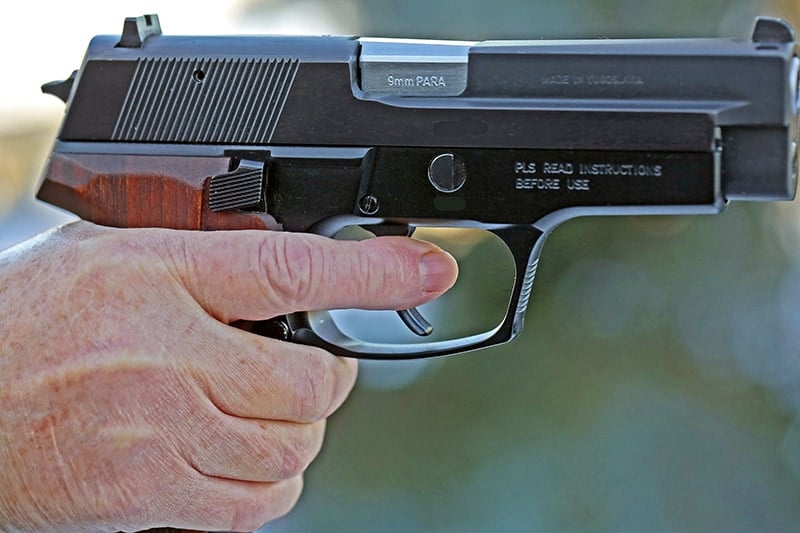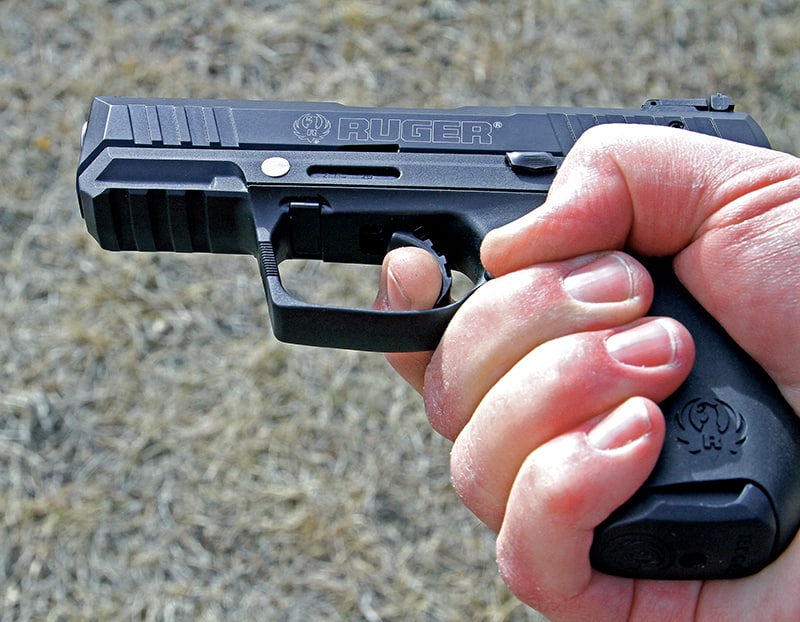Simple Is Not Always Easy
Two hands on the gun are better than one. The gun is held more steadily, and having the gun as still as possible is one of the keys to accurate shooting. Recoil recovery is faster so the rate of accurate fire is increased. With proper technique there is little if any sacrifice in speed in return for the benefits provided.
There’s another factor, which is both good and bad. The two-hand hold helps compensate for minor errors, especially errors in trigger control. This is a good thing. Still, if we want to achieve a higher level of competence we need to recognize and correct errors, replacing “adequate” skills with superior skills.
Shooting with one hand (“strong hand only” or “weak hand only”) makes errors in trigger management more obvious. A very common error, so common you can practically count on it, is the trigger finger pushing the gun to the open side (to the left, if the gun is in the right hand) during the trigger press. With the two-hand grip the support hand counters this sideways pressure.
Sideways pressure during the trigger press is a bit difficult to diagnose, since pushing shots low and left (for a right-handed shooter) can result from an incipient flinch, anticipating the shot. Also the gun tends to recoil away from its main point of support. Unless the gun is recoiling more or less straight back into the web of the hand it will tend to move toward the open side during recoil.
If you’re shooting nicely centered groups with your normal two-hand hold, then see shots going left but at the same elevation when shooting right handed only, it’s most likely due to pushing with the trigger finger.
Reasonably Competent
A beginning shooter is well advised to use the 2-hand hold at least until a reasonable degree of competence has been developed. Trying to learn too much at once generally results in nothing being learned.
Developing one skill at a time is tough enough. Accurate shooting is really a simple process. Hold the gun steadily, hold it the same way for every shot, index the gun on target and press the trigger to release the shot without imparting movement to the gun. Trouble is, people read “simple” to mean “easy.” The process is simple — doing it well is hard. It takes time, disciplined training and thousands of repetitions to develop this simple process and make it permanent.
What would be a reasonable degree of competence? It’s a matter of opinion, but I’d say if you can hit a 10″ diameter target every time at a distance of 10 yards you’re reasonably competent. Note I don’t mean shooting 10″ groups. I mean hitting an actual 10″ diameter target every time.
To achieve this the shots can’t be randomly distributed over the circle; the majority of bullet holes will be clustered in the central portion of the target, with only the occasional not-so-good shot around the edges. I’d make a small bet the majority of handgun shooters couldn’t do it. I’d also bet the majority of their handguns aren’t sighted well enough to hit center even if they did everything right. No … really.
Self-Defense Thoughts
Once you’ve achieved this reasonable degree of competence shooting with both hands, consider devoting the next few training sessions to shooting strong hand only. By this I don’t mean banging off a magazine or two strong one-handed now and then. You won’t learn anything (other than it’s hard) and it’s mostly a waste of ammo. I suggest beginning and ending a training session with 10 shots using the two-hand grip, fired as accurately as possible. This is to reinforce the image of a precise sight picture and careful trigger press. It also confirms the handgun is shooting to point of aim.
Devote the balance of the session to developing one skill at a time. Set a goal — in this case it’s hitting a 10″ diameter target every time at 10 yards, strong hand only — and work at it as many sessions as it takes.
If I was still competing I’d be devoting a lot more training time to shooting with one hand. You have to pay more attention to the details of trigger control when shooting one-handed. Placing the trigger finger squarely across the face of the trigger and pressing it straight back, without any sideways pressure, is critical and mistakes are amplified shooting one-handed.
I’m mainly a competition and recreationally oriented shooter. I think for those primarily concerned with self-defense, achieving skill with one hand on the gun is even more important. There can be a multitude of reasons why the support hand won’t be available. It might be needed to hold a steering wheel, to close a door, fend off an assailant or to pull an innocent party out of the line of fire. Not likely to happen? Well, statistically we’re not likely to need a gun at all, but we prepare nonetheless!

Get More Personal Defense Tips!
Sign up for the Personal Defense newsletter here:





